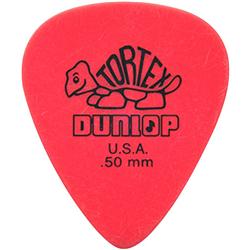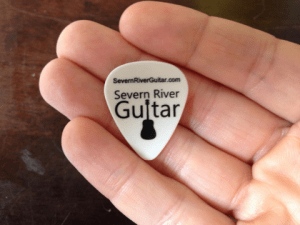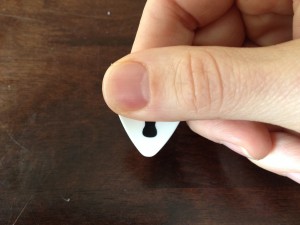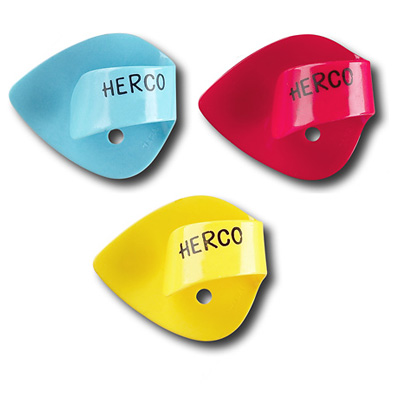This post may contain affiliate links. Please read my disclosure for more info.
UGH! This sucks. Not only do my fingers hurt from pressing down strings, but the pick keeps slipping every time I start to get into a nice strumming pattern. I thought I was making progress!!
Yeah, it’s a bummer. But it’s pretty easy to fix. Here are a few recommendations.
What Kind of Pick are You Using?
With so many different styles of music, and so many different kinds of guitars, it only makes sense that there would be a ton of different kind of guitar picks (sometimes referred to as plectrums). Here, we are going to focus probably the most widely available and (arguably) the most popular picks. They are usually made out of plastic, look like little triangles with rounded edges, and vary in thickness. They look like this:

Generally, picks start to slip and slide around when you start strumming (as opposed to picking out individual notes… though that happens too).
Our focus here will be on strumming. Let’s use the above pick as an example. The above pick is relatively thin (.50 mm). Thin picks are floppy.
I prefer something a little thicker when strumming on an acoustic guitar (.70 mm – .80 mm, or a “medium” thickness). It comes down to personal preference, and there isn’t really a right or wrong size…usually.
However, I find that thinner picks are usually easier to control when you’re a beginner guitar player.
Thicker picks have a tendency to slide around as you start to strum.
Are You Holding Your Pick Correctly?

Now that we’ve got our pick identified, let’s make sure you’re holding it correctly.
There are a few ways you can hold your pick – and oddly enough, the type of music you play may have an impact on how you hold your pick.
For example, if you want to play those awesome quick notes of Gypsy Jazz players, you’ll be using a super thick pick (like the thickness of a big button that’s been kind of shaved down) and it will be kind of clenched in your fingers.
But we’re not doing that here.
So how should you hold your picks? Like this:

The other side should look like this:

Make sure there is a little bit of plastic showing. Here’s another view:

Keep in mind – there are tons of different techniques and ways of holding your pick. I’ve found that this variation is pretty common, easy to do, and a great way for beginners to get started.
Ok. Now that we’ve got our grip down, we need to figure out how hard to squeeze.
This will largely depend on the song, style, or volume of music you’re playing.
For our purposes, I’d suggest starting out by pinching the pick so that if you actually pinched your forearm with the same tension – it would only barely start to hurt.
Got it?
Ok.
Now…
How Are You Strumming?
I think in most cases, the pick will slip and slide around because we’re not really strumming very well. When the pick hits your guitar strings, it should be at about a 45 degree angle.
If you strum at a lower angle the picks will barely hit the strings and it will be tough to get a good sound.
On the other hand, if the pick hits the strings at a right angle you’re going to have a lot of trouble strumming. In this case you will meet a lot of resistance when you’re pick hits the strings.
It’s this resistance that causes your pick to move around.
Whether you’re using down strums or up strums, try to hit the strings at a 45 degree angle.
This can take a bit of practice. Here are two analogies I like:
1. Compare your strum to a paint brush stroke. Rather than striking the strings, think more about quickly and gently brushing up and down on the guitar strings. This requires a little movement in your elbow (as you strum), but also rotation in your forearm, almost like you were…
2. Turning a doorknob. This is my favorite analogy. Put your arm out and pretend like you are turning an imaginary doorknob. See how your whole forearm rotates? Now keep performing that motion and start to bring your forearm to your body (like you are about to strum a guitar). Now bend your elbow up and down while still rotating your forearm. Try to get the timing so that when your elbow comes up, your forearm rotates so that the pick is pointing to your chest. When the elbow goes down, your pick is pointing to your belt buckle/waist.
Try not to be too robotic about it… though it may take a bit of practice.
Where is your Pick Pointing?
The last suggestion I have has to do with the direction your pick is pointing.
Try to have the pointy part of the pick pointing slightly towards the bridge of the guitar.
I’ve found that pointing your pick in this direction gives you better leverage, which in turn prevents the pick from slipping around in the opposite direction.
This leverage also gives you better control over how hard or soft you grip the pick, which makes your playing more dynamic.
Or… Try this Quick Fix…
Even now, after playing guitar for 20 years, I still slip up.
It’s normal.
When it happens just move the pick back into place. The important thing is to become comfortable and used to the way the pick feels in your fingers – so when it starts to slip, you’ll notice and be able to make a quick adjustment.
Or…
You can buy picks that are sort of textured and grippy. Something like Jim’s Pick (my full review of these grippy guitar picks is available here).
Or you can take some sandpaper and roughen up your picks.
Or maybe even just glue a little but of fine-grit sandpaper to your picks. No harm.
Another solution is to try out these awesome Herco picks …

I love these little guys and used to use them exclusively when playing live acoustic music. I suggest the medium thickness (the heavy ones were too bulky and the light ones seemed to break more frequently).
I used them because I did a lot of finger picking mixed with strumming and these picks allowed me to do both really easily. I also like them because they do a great job of training your fingers to nice way of holding your pick. Try them out, they’re only like $1 or something.
That’s it! I’d love to hear what you think – if you agree or disagree. Let me know!
UPDATE: I have a few open spots for Online Guitar Lessons email me if you’re interested at jake@jakeposko.com
22 replies on “My Guitar Pick Keeps Slipping Out of My Fingers (or How to Hold a Guitar Pick)…”
[…] https://severnriverguitar.com/2022/03/04/my-guitar-pick-keeps-slipping-out-of-my-fingers-or-how-to-h… […]
[…] https://severnriverguitar.com/2022/03/04/my-guitar-pick-keeps-slipping-out-of-my-fingers-or-how-to-h… […]
[…] https://severnriverguitar.com/2022/03/04/my-guitar-pick-keeps-slipping-out-of-my-fingers-or-how-to-h… […]
[…] tip to remember is to point the pick slightly towards the bridge when […]
What I found to work best to keep my pick from slipping is a product called Grip Skin. Its a rubber coating that is applied to Picks and sticks for a better grip. Its very affordable and has really helped my performance. Their website is http://www.gripskin.net – I have also seen it on Reverb, Ebay, and Amazon
Thank you! I started with strumming and started to face the slipping problem. Your tips really helped 🙂